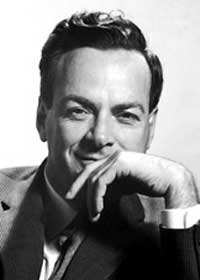

(May 11, 1918 – February 15, 1988)
To many, Richard Feynman is an inspiration. Without a doubt, he was the same caliber of man, as well as scientist, as Carl Sagan, Neil Degrasse Tyson, and Bill Nye.
He was a scientist, a teacher, a musician, and an icon. In the physics community, he is heralded as one of the most prominent theoretical physicists. Modern science owes a lot to Feynman, for both his work and the encouraging words he left to the next generation of scientists.
In addition to his formal education, Feynman spent a lot of time on “self education.” Through the power of reading, he was able to teach himself concepts and subjects far ahead of what he was learning in school. In an interview, Feynman credits a book series “Algebra for the practical man” with much of his learning. You can still find these books online and can download PDF versions of some of them.
Later, Feynman went to Princeton University, where he got a perfect score on the entrance exam in mathematics and physics (this is no easy task). During his time there, he took classes with scientists such as Albert Einstein, Wolfgang Pauli, and John won Neumann. For his doctoral work, Feynman – along with his thesis adviser John Archibald Wheeler – laid the groundwork for “path integral formulation” as well as “Feynman diagrams.” He would continue this pioneering work throughout his career.
Feynman was also one of the scientists assigned to work on the Manhattan and Trinity projects during World War II. He was a junior scientist, but even then, Feynman helped to solve difficult equations, including the formula for calculating the yield of a fission device. In his spare time, Feynman was known for playing practical jokes around the top-secret facility. Some of which terrified the prankee into thinking nuclear secrets had been stolen by German spies (Feynman discovered the combination to the locked filing cabinets belonging to nuclear physicist Frederic de Hoffmann, and left a series of cryptic notes inside. The joke briefly spooked Hoffman into believing that a saboteur had gained access to secrets of the atomic bomb).
Much later, during one of the darker periods in U.S. spaceflight, Feynman served on the Challenger inquisition board.
Feynman received awards and commendations throughout his life (most notably, the Nobel Prize in 1965 and the National Medal of Science in 1979). These, however, aren’t some of the most interesting facts about the late-scientist.
During the Manhattan project in 1945, his wife Arline died of Tuberculosis. In 1946, Feynman wrote a letter to his deceased wife, his final words in the letter were:
My darling wife, I do adore you.
I love my wife. My wife is dead.
Rich
P.S. Please excuse my not mailing this – but I don’t know your new address.
This goes to show that, even in tragedy, he never lost his sense of humor.
Feynman had a “curious character,” and he loved to question everything around him (his second wife even cited this as a reason that she filed for divorce). Feynman also lived by the mantra that he would rather not have an answer to a question instead of having the wrong answer.
Feynman also had a neurological condition called “Synesthesia.” Synethesia is a condition in which triggering one sense activates another sense (it’s a stimulation in one cognitive or sensory pathway that leads to involuntary and automatic experiences in a second cognitive or sensory pathway). In particular, Feynman was a grapheme or color synesthete, which means he associates letters and numbers with colors.
As an example, a person with this may associate ‘A’ with pink and the number ‘2’ with green. In general, this tends to be very helpful with remembering long strings of numbers and words – simply because they are ‘pretty’ and not just a string of text. Other forms of synesthesia include seeing colors for musical notes or even associating names with tastes.
Unfortunately, there is a lot that will be left out about Feynman in this short description: How he used to fix his neighbors radios as a child, the fact that he was an avid bongo player, and on and on. But he is definitely a man that we should remember and honor as much as we are able.
“The worthwhile problems are the ones you can really solve or help solve, the ones you can really contribute something to. … No problem is too small or too trivial if we can really do something about it.”
–Richard Feynman
This article is part of Know Your Scientist, a series on various influential scientists throughout the ages.